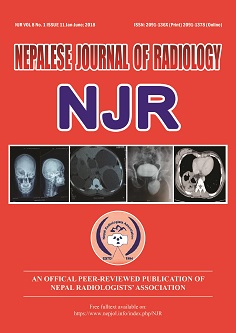The Prevalence of Protrusion of Infraorbital Nerve into Maxillary Sinus Identified on CT Scan of the Paranasal Sinuses at a Tertiary Hospital in Nepal
DOI:
https://doi.org/10.3126/njr.v8i1.20440Keywords:
Computed Tomography, Infraorbital Canal, Infraorbital NerveAbstract
Introduction: The variation in the course of infraorbital canal and protrusion of the infraorbital nerve through it to the maxillary sinus may lead to its accidental injury during reconstructive or endoscopic sinus surgery. Preoperative identification of this variant will prevent unintended injuries.
Methods: A retrospective study of 307 patients who underwent CT scan study of the paranasal sinuses at Chitwan Medical College, Nepal was conducted. The protrusion of infraorbital nerve to the maxillary sinus was identified and the length of the bony septum along with the infraorbital nerve was measured. It was further classified as Class I to III according to the length of the septum.
Results: The prevalence of protrusion of inferior orbital nerve in our study was 11.40 % and bilateral protrusion was 5.8 %. The median length of the protruding component along with the septum was 4.9 mm.
Conclusion: Preoperative identification of the normal protrusion of infraorbital nerve to the maxillary sinus will prevent accidental injuries during sinus surgery. CT scan of the paranasal sinus would be the modality of choice for identification of this variant.
Downloads
Downloads
Published
How to Cite
Issue
Section
License
This license enables reusers to distribute, remix, adapt, and build upon the material in any medium or format, so long as attribution is given to the creator. The license allows for commercial use.




